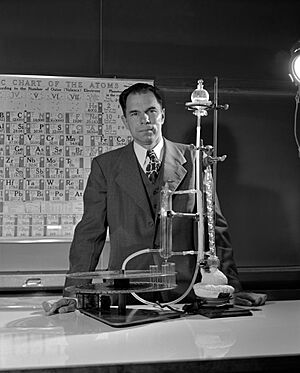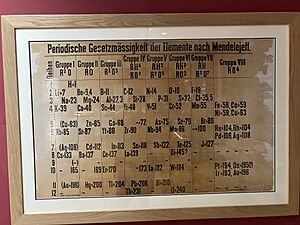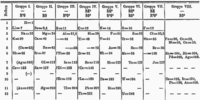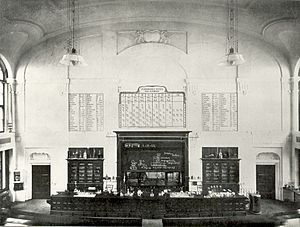History of the periodic table facts for kids

The periodic table is a special chart that organizes all the known chemical elements. It's arranged based on their atomic number (how many protons they have), how their electrons are set up, and their repeating chemical properties.
Imagine a giant puzzle where each piece is a different element. The periodic table helps us put these pieces in order so we can see patterns. Elements are listed by their atomic number, which usually goes up one by one. But then, new rows and columns are started to group elements with similar behaviors. These rows are called periods, and the columns are called groups. For example, all elements in group 18 are noble gases. These gases are very unreactive, meaning they don't easily mix with other elements.
The history of the periodic table shows how our understanding of elements grew over more than 200 years. Many smart scientists helped, like Antoine-Laurent de Lavoisier, Dmitri Mendeleev, and Glenn T. Seaborg.
Contents
Early Ideas About Elements
Around 330 BCE, the Greek philosopher Aristotle thought that everything was made of four basic "roots": earth, water, air, and fire. Other ancient cultures had similar ideas.
Some chemical elements we see on the periodic table today have been known for a very long time. Nine of them—carbon, sulfur, iron, copper, silver, tin, gold, mercury, and lead—were known in ancient times. This is because they can be found naturally or are easy to get using simple tools. Five more elements were found during the age of alchemy, like zinc and arsenic. Platinum was known in South America long ago, but Europeans didn't learn about it until the 1500s.
First Ways to Group Elements

The story of the periodic table is also the story of how new elements were found. The first person known to discover a new element was Hennig Brand, a German merchant. In 1669, he was trying to find the philosopher's stone (a mythical item that could turn cheap metals into gold). Instead, he accidentally made a glowing white substance from human urine. He called it "cold fire." Later, in 1680, another chemist, Robert Boyle, also found this substance, which we now call phosphorus. This discovery made scientists wonder what exactly an "element" was.
In 1661, Robert Boyle defined elements as "simple Bodies" that make up other mixed substances and cannot be broken down further.
In 1789, the French chemist Antoine Lavoisier wrote the first modern textbook about chemistry. He said an element was a substance that couldn't be broken down into anything simpler. His book listed "simple substances" like oxygen, nitrogen, hydrogen, phosphorus, mercury, zinc, and sulfur. These formed the base for our modern list of elements. Lavoisier also included "light" and "caloric" (heat) because people thought they were materials back then. He sorted his substances into metals and nonmetals.

Between 1808 and 1810, British scientist John Dalton came up with a way to figure out the atomic weights of elements. His atomic theory was used by many chemists.
In 1817, German physicist Johann Wolfgang Döbereiner started trying to classify elements. By 1829, he found he could group some elements into sets of three, called triads. Elements in a triad had similar properties.
- Döbereiner's Triad Law:
Elements with similar chemistry, when put in order of their atomic weights, formed groups of three. In these groups, the atomic weight of the middle element was usually the average of the other two. * chlorine, bromine, and iodine * calcium, strontium, and barium * sulfur, selenium, and tellurium * lithium, sodium, and potassium
Early attempts to sort elements by atomic weight were tricky because the weights weren't always accurate. For example, carbon and oxygen were thought to be half their actual masses. It wasn't until the late 1850s, after Stanislao Cannizzaro's work, that scientists widely accepted the correct atomic weights.
In 1860, a big meeting called the Karlsruhe Congress helped scientists agree on a revised list of elements and their atomic masses. This made it easier to create more complete systems for organizing elements.
Creating the First Periodic Tables
Properties of the elements, and thus properties of light and heavy bodies formed by them, are in a periodic dependence on their atomic weight.
In 1862, French geologist Alexandre-Émile Béguyer de Chancourtois noticed that if elements were ordered by their atomic weights, similar properties appeared regularly. He made a 3D chart called the "telluric helix." Elements were arranged in a spiral on a cylinder. Elements with similar properties lined up vertically.
The next try was in 1864 by British chemist John Newlands. He classified 62 known elements. Newlands saw that physical properties repeated every eight elements when ordered by mass. He called this the "law of octaves," like musical notes. However, his table didn't leave spaces for new elements, and sometimes put two elements in the same spot. Other scientists didn't take his work seriously at the time.
German chemist Lothar Meyer also saw that similar chemical and physical properties repeated at regular intervals. In 1864, he published a table with 28 elements, grouped by their valence (how many bonds they can form). This was the first time elements were grouped this way. In 1870, Meyer published a new table with 55 elements. He also showed how the physical properties of elements changed in a repeating pattern.
In 1869, Russian chemist Dmitri Mendeleev arranged 63 elements by increasing atomic weight. He noticed that chemical properties repeated across columns. Some say he played "chemical solitaire" with cards of elements. Mendeleev used these patterns to suggest that some atomic weights were wrong and changed their places. For example, he changed beryllium's atomic weight and valency. He shared his table with many chemists. In 1871, he further developed his ideas and created what he called the "law of periodicity."
- Early attempts to create a periodic table
Mendeleev's Amazing Predictions
| Name | Atomic weight | Modern name (year of discovery) |
|
|---|---|---|---|
| Mendeleev | Modern | ||
| Eka-boron | 44 | 44.6 | Scandium |
| Eka-aluminum | 68 | 69.2 | Gallium |
| Eka-silicon | 72 | 72.0 | Germanium |
| Eka-manganese | 100 | 99 | Technetium (1925) |
| Dvi-tellurium | 212 | 210 | Polonium (1898) |
| Dvi-caesium | 220 | 223 | Francium (1937) |
| Eka-tantalum | 235 | 231 | Protactinium (1917) |
Mendeleev realized that some elements were still missing from his table. He bravely predicted the properties of these undiscovered elements! In 1870, he gave detailed predictions for three elements he called eka-boron, eka-aluminium, and eka-silicium. The prefixes eka, dvi, and tri come from Sanskrit words for one, two, and three.
Mendeleev's 1869 table had some elements in the wrong places, like indium and some rare-earth metals. These elements confused him because they didn't fit the pattern of increasing valency. He thought their atomic weights might be wrong. He even measured the heat capacity of some elements to prove his ideas, and he was right!
Mendeleev also noticed a big gap between cerium and tantalum. He thought there must be a whole row of undiscovered elements there, which would act like heavier versions of elements above them. He predicted 18 elements in total, and about half of them were later discovered.
Mendeleev's Table Gets Famous

At first, not everyone accepted Mendeleev's table. But his predictions started coming true!
- In 1875, eka-aluminium was discovered and named gallium.
- In 1879, eka-boron was discovered and named scandium.
- In 1886, eka-silicium was discovered and named germanium.
Mendeleev was even able to correct some early measurements of these new elements. For example, he told the discoverer of gallium, French chemist Paul-Émile Lecoq de Boisbaudran, to re-measure its density. Boisbaudran was surprised but found Mendeleev was right! These successes helped make Mendeleev's periodic table famous.
By 1890, Mendeleev's periodic table was widely accepted as a basic part of chemistry.
Noble Gases and Atomic Structure
The great value of Newland's, Mendeleef's, and Lothar Meyer's generalisation, known as the periodic arrangement of the elements, is universally acknowledged.
Discovering Noble Gases
In 1894, British chemists William Ramsay and Lord Rayleigh found a new element in the air called argon. Argon was very unusual because it didn't react with other chemicals and was monatomic (meaning its particles were single atoms, not groups of atoms). It didn't seem to fit into the periodic table. Mendeleev first thought argon was just a different form of nitrogen.
Ramsay kept looking and, in 1898, discovered more of these unreactive gases: neon, krypton, and xenon. These five new gases (argon, helium, neon, krypton, xenon) were called noble gases and were placed in a new column in the periodic table. Mendeleev's table hadn't predicted them, but he eventually agreed to add them as "group 0" in 1902. This showed how flexible and powerful his table was.
In 1905, Swiss chemist Alfred Werner helped solve a puzzle in Mendeleev's table. He figured out that the rare-earth elements (also called lanthanides) fit into a gap in the table. Mendeleev knew about some of these elements but couldn't place them because their exact number and order weren't known. This discovery led to a new way of showing the periodic table, sometimes with 32 columns.
Radioactivity and Isotopes
In 1907, scientists found that some radioactive substances, like thorium and radiothorium, were chemically the same but had different atomic weights. In 1910, Frederick Soddy suggested these were the same element but with different atomic weights. He later called them "isotopes," meaning "same place" in Greek.
Before this, scientists found many new radioactive substances from the decay of uranium and thorium. They thought these were all new elements, which would have made the periodic table too crowded! But Soddy and Kazimierz Fajans showed in 1913 that many of these substances were chemically identical. They were just different versions of the same element—isotopes.
Atomic Number and the Modern Table
In 1913, a Dutch physicist named Antonius van den Broek suggested that the atomic number (the number of protons in an atom's nucleus) was what really determined an element's place in the periodic table, not its atomic weight.
British physicist Henry Moseley decided to test this idea. He studied the X-rays that elements give off. He found a clear relationship between the X-ray wavelength and the element's atomic number. This allowed him to measure atomic numbers accurately and put the elements in the correct order.
Moseley's work solved some big problems:
- It correctly placed argon (atomic number 18) before potassium (atomic number 19), even though argon has a slightly higher atomic weight.
- It also correctly placed cobalt before nickel, and tellurium before iodine.
- It even helped prove that a claimed new rare-earth element wasn't actually new.
Moseley's research also showed exactly where the missing elements were in the table. For example, there were gaps at atomic numbers 43 (technetium), 61 (promethium), 72 (hafnium), 75 (rhenium), 85 (astatine), and 87 (francium).
Electron Shells and Quantum Mechanics
In 1888, Swedish physicist Johannes Rydberg noticed a pattern in the atomic numbers of noble gases. This helped explain why periods in the table had fixed lengths. It also led to the idea that noble gases are stable because their electrons fill up "shells" around the nucleus. This is the basis of the modern octet rule, which says atoms are stable when they have eight electrons in their outer shell.
In 1919, American chemist Irving Langmuir suggested that electrons are arranged in "equidistant layers" (now called shells) and "cells" (now called orbitals), with each orbital holding two electrons.
In 1921, British chemist Charles Rugeley Bury suggested that eight and eighteen electrons in a shell create stable arrangements. He also used the term transition to describe elements like transition metals, explaining their properties by the filling of inner electron shells.
The development of quantum mechanics in the 1910s and 1920s helped us understand how electrons are arranged in atoms. Niels Bohr proposed that elements in the same group behave similarly because they have similar electron arrangements. This confirmed the idea that electron configurations determine chemical properties.
Protons and Neutrons
The discovery of the proton and neutron showed that atoms could be divided. This changed Lavoisier's old definition of an element. Today, a chemical element is defined by the number of protons in its atoms, which is exactly its atomic number. This also helped explain how radioactive decay works.
Later, scientists found that protons and neutrons are made of even smaller particles called quarks.
Modern Expansions of the Table
Around 1925, the periodic table changed its look. Some rows were shifted to the right, creating extra columns. The original groups (I–VII) were repeated, but with "A" and "B" added to tell them apart.
Actinides
In 1940, neptunium and plutonium were the first elements heavier than uranium (called transuranic elements) to be discovered. At first, they were placed in the main part of the table. However, their chemistry seemed more like uranium than other elements in those spots.
During World War II, American chemist Glenn T. Seaborg was working on the Manhattan Project. He had trouble isolating americium and curium. In 1945, he suggested a big change to Mendeleev's table: the actinide series.
Seaborg proposed that the actinides (elements from actinium onwards) form a special "inner transition" series, similar to the rare-earth elements (lanthanides). This meant they would be placed in a separate row at the bottom of the table. This idea helped scientists understand the chemistry of these heavy elements and led to the discovery of even more elements, like berkelium in 1949.
Beyond Period 7
Seaborg also thought about even heavier elements, predicting a transactinide series and a superactinide series. He imagined an extended periodic table with an eighth period, adding 50 more elements. However, his model didn't fully consider "relativistic effects." These are special effects that happen when electrons move very fast in heavy atoms.
Scientists like Burkhard Fricke and Pekka Pyykkö used computers to calculate the positions of elements up to atomic number 172. They found that relativistic effects could change where some elements would appear in an extended table. This means that elements in future periods might not follow the same patterns as the ones we know.
The discovery of tennessine in 2010 filled the last empty spot in the seventh period. Any new elements found will start an eighth period.
However, the chemistry of some very heavy elements doesn't always match the periodic law perfectly. This means scientists are still working to understand how the periodic law applies to these superheavy elements.
Images for kids
-
Geoffroy's 1718 Affinity Table: at the head of each column is a chemical species with which all the species below can combine. Some historians have defined this table as being the start of the chemical revolution.









